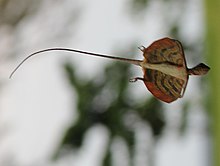Gliding lizard
| Draco | |
|---|---|
 |
|
| Draco taeniopterus in mid-glide, from Bulon Island, Thailand. | |
 |
|
| Male Draco spilonotus extending the gular flag (throat flap) and patagia ("wings") in Sulawesi, Indonesia | |
| Scientific classification | |
| Kingdom: | Animalia |
| Phylum: | Chordata |
| Class: | Reptilia |
| Order: | Squamata |
| Suborder: | Iguania |
| Family: | Agamidae |
| Subfamily: | Draconinae |
| Genus: |
Draco Linnaeus, 1758 |
Draco is a genus of agamid lizards that are also known as flying lizards, flying dragons or gliding lizards. These lizards can move by gliding; their ribs and their connecting membrane may be extended to create "wings" (patagia), the hindlimbs are flattened and wing-like in cross-section, and a flap on the neck (the gular flag) serve as a horizontal stabilizers. Draco are arboreal insectivores. While not capable of powered flight they often obtain lift in the course of their gliding flights. Glides as long as 60 m (200 ft) have been recorded, over which the animal loses only 10 m (33 ft) in height, which is quite some distance, considering that one of these lizards is only around 20 cm (7.9 in) in total length (tail included).
The only time a flying lizard ventures to the ground is when a female is ready to lay her eggs. She descends the tree she is on and makes a nest hole by forcing her head into the soil. She then lays 2–5 eggs before filling the hole. She guards the eggs for approximately 24 hours, but then leaves and has nothing more to do with her offspring.
Carl Linnaeus derived the name of this genus from the Latin term for mythological dragons.
The following 42 species are recognized:
Nota bene: A binomial authority in parentheses indicates that the species was originally described in a genus other than Draco.
The lizards are well known for their "display structures" and ability to glide long distances using their wing-like, patagial membranes supported by elongated thoracic ribs to generate lift forces.
Draco dussumieri features prominently in Poornachandra Tejaswi's Kannada novel Carvalho (ಕರ್ವಾಲೊ). In this story, middle aged scientist Carvalho, searches for this flying lizard in the forests of the Western Ghats in the Indian state of Karnataka.
...
Wikipedia
